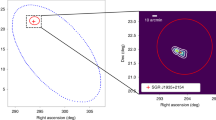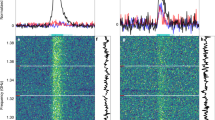Abstract
RECENT observations from the BATSE experiment on the Gamma Ray Observatory1,2 demonstrate that the number of weak γ-ray bursts is smaller than expected for a uniform distribution of source distances, and that the distribution of weak bursts is isotropic. This suggests that the sources are at cosmological, rather than intragalactic, distances3,4. A number of possible tests for estimating the distances to γ-ray bursters have been discussed3, but all are difficult to implement in practice. There is therefore no further evidence at present to support a cosmological distance to the bursters. Here I describe a test of distances that might be done with the BATSE data, which is equivalent to the formulation of the Hubble diagram for galactic redshifts. If the typical redshift of γ-ray bursters is of the order of unity, the weakest bursts should have softer spectra than the strongest. There is some evidence for such a correlation in the BATSE data5. If confirmed, this would provide the first spectroscopic indication that the burst sources lie at cosmological distances. There is also evidence that the redshift effect has been detected in the duration of a subset of the BATSE bursts6. If confirmed, this would be evidence that not only the photons but also the light curves are stretched by the cosmological redshift.
This is a preview of subscription content, access via your institution
Access options
Subscribe to this journal
Receive 51 print issues and online access
$199.00 per year
only $3.90 per issue
Buy this article
- Purchase on Springer Link
- Instant access to full article PDF
Prices may be subject to local taxes which are calculated during checkout
Similar content being viewed by others
References
Fishman, G. J. et al. presented at Second Gamma Ray Observatory Workshop, 23–25 September (Annapolis, Maryland, 1991).
Meegan, C. A. et al. IAU Circ. No. 5358 (1991); Nature 355, 143–145 (1992).
Paczyński, B. Acta Astr. 41, 257–267 (1991).
Mao, S. & Paczyński, B. Astrophys. J. (submitted).
Paciesas, W. et al. presented at Huntsville Gamma-Ray Burst Workshop, 16–18 October (Huntsville, Alabama, 1991).
Kouveliotou, C. et al. presented at Huntsville Gamma-Ray Burst Workshop, 16–18 October (Huntsville, Alabama, 1991).
Weinberg, S. Gravitation and Cosmology (Wiley, New York, 1991).
Higdon, J. C. & Lingenfelter, R. E. Ann. Rev. Astr Astrophys. 28, 401–436 (1990).
Author information
Authors and Affiliations
Rights and permissions
About this article
Cite this article
PaczyŃski, B. Estimating redshifts for γ-ray bursts. Nature 355, 521–522 (1992). https://doi.org/10.1038/355521a0
Received:
Accepted:
Issue Date:
DOI: https://doi.org/10.1038/355521a0
This article is cited by
-
Observational post gamma-ray burst manifestations in the cosmological model due to its interaction with the galactic gas
Astrophysics and Space Science (1996)
-
Relativity at action or gamma-ray Bursts
General Relativity and Gravitation (1996)
-
Cosmological rates of coalescing neutron stars and GRB
Astrophysics and Space Science (1995)
-
Tests for coalescing binary neutron stars as cosmological origin of gamma-ray bursts
Space Science Reviews (1995)
-
What we knew, what we know and what we will know about cosmic gamma-ray bursts
Space Science Reviews (1995)
Comments
By submitting a comment you agree to abide by our Terms and Community Guidelines. If you find something abusive or that does not comply with our terms or guidelines please flag it as inappropriate.



